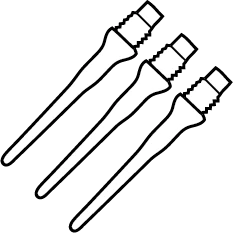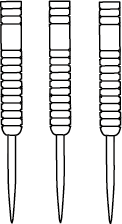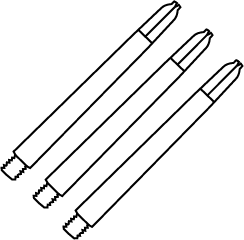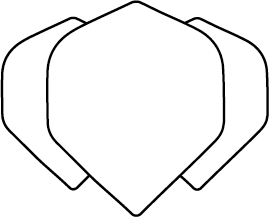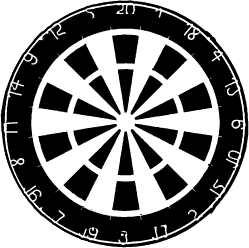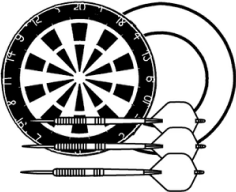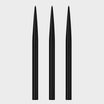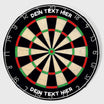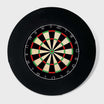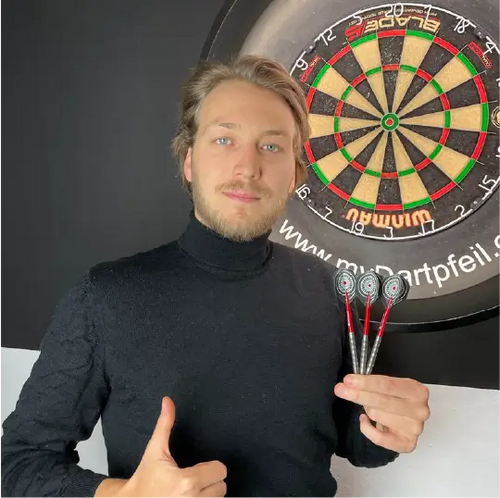Regular dart training is one of the most important components for long-term, successful and consistent darts play. However, the question often arises as to how to train correctly and which exercises actually make sense.
In this article we will explain which darts training is effective and will permanently raise you to a higher level .
Dart training for beginners: Example of a training plan
Especially as a beginner, you shouldn't set your goals too high, as this will inevitably lead to frustration. Always remember that even professionals are always striving for absolute perfection – but it doesn't exist.
So start slowly and don't overexert yourself at the beginning so you can really enjoy the game for a long time. You can also always play dart practice games on your own if you have a dartboard at home—which is, of course, recommended.
The warm-up exercise – hitting the individual fields safely
A popular warm-up exercise is throwing all the individual segments at the dartboard. You can adapt this exercise to your own skill level to make your dart practice and overall training plan more effective .
So you start at 1 and work your way up to segment 20. For a beginner or casual hobby player, the goal might be to hit every single field in one shot . That is, to hit all 20 individual segments with 60 arrows.
However, if this is too easy for you, you can of course make the exercise a bit more difficult. For example, you could try starting over every time you don't capture the individual segment in one shot.
This also allows you to practice handling pressure situations . Such a situation arises, for example, when you miss the target segment with the first two arrows of a shot.
Intensify dart training – now it’s time for the double fields
Once you've hit all the singles, you can apply the same exercise to all the doubles . Of course, you won't be able to hit the double with three arrows on every single field.
However, there's no specific number of throws you need to stick to here. Every player has a few favorite doubles and some less favorite doubles. It makes much more sense to calculate the total number of darts . Then add up all the darts you needed to hit all the doubles.
This can be a good guide for you and you can try to break your own records over time . This will allow you to compare your own performance and provide you with an incentive to improve.
Many players complement the two exercises mentioned above by also trying to incorporate the bull's-eye into their practice. Of course, dart training doesn't just consist of drills.
Of course, for fun, you should also play a few games and dart elimination . Whether it's 301, 501 , or 701, it doesn't matter. The main thing is that you have fun .
The triple fields – a supreme discipline
If you want to really put your nerves to the test, I recommend incorporating the following exercise into your training plan.
Try the above exercises with the triple squares as well. However, it's sufficient here if you limit yourself to the triple squares from triple 10 up to triple 20 .
With this exercise, you'll quickly realize that you 'll need a lot of patience , and your frustration threshold will gradually decrease. It can easily take several minutes to hit a triple. So, don't put too much pressure on yourself during your darts training, especially at the beginning.

The average and the high triple fields
As a final exercise, we'd like to introduce you to two combined options. You can incorporate these into your training plan. If you want to work on your average , you can, for example, play 60 shots .
You record each score to calculate the average . Here, too, you can see a clear trend over time.
You'll almost certainly try to hit only the high triples to boost your average. So if you only want to hit individual spaces, you can try shooting 100 times at the 20, 19, or 18.
You can also vary the game as follows: You count a single hit as one point, a double hit as two, and a triple hit as three. This way, you can calculate the total after your 100 darts and also check yourself. Ultimately, this also allows you to better compare your performance during dart practice.
The best dart training is the competition
You can easily complete all of the exercises mentioned above at home. But the same applies to darts: the best darts training is competition.
So try teaming up with a few friends to play regular matches . It doesn't matter whether you're playing 501-Double Out, Round the Clock , or cricket .
It is important that you use the entire board to play and learn how to deal with pressure situations .
Darts is largely a mental sport . Anyone who underestimates this will quickly find themselves in trouble in competition. This is precisely why it's so important to continually train under competitive conditions.
This will help you learn to withstand the mental pressure . We've written a separate blog article with important tips and tricks for successful dart mental training . You can find it here.

6 tips for successful dart training
Darts and a board are quick to buy, and the rules of darts are usually familiar. But that doesn't mean it's easy and you'll master the game right away.
Practice makes perfect , and you won't be able to avoid it either. To master the game, here are some tips to help you with your darts training.
-
Tip 1 - Determine your dominant eye: To hit the targets, you need to know which eye is dominant. Usually, it's the right eye , but there are some exceptions where the left eye is dominant.
To find out, point an arrow at the bullseye . Now close your right eye.
If the arrow is still on target, your left eye is your dominant eye. You'll notice that the arrow is significantly off target if you close your left eye and look with your right eye. -
Tip 2 – Use the following through: You should definitely avoid throwing the arrow using your finger strength. Speed is determined by forearm strength .
If you have thrown correctly, at the end of the throwing movement your arm will point towards the board, be fully extended and your wrist will be bent.
This follow-through motion is called following through and will help you hit a consistent release point. - Tip 3 – Play with experienced players: If you always play alone, you won't be motivated. However, if you have opponents who are significantly better , your inner Monk will awaken and want to improve as well. You'll also receive plenty of tips and tricks from experienced players on how to improve your game.
-
Tip 4 – Darts courses are helpful: Many cities offer darts courses . These can be very helpful because you play with many different players and might even pick up a few tricks.
Furthermore, the trainers are perfect for observing you closely and telling you where you are making mistakes or what you are doing well. -
Tip 5 – Document your results: How many darts did you throw or what was your highest score? All of these results are worth recording.
This way, you'll have an overview of your improvement and also see your personal records and personal bests . Only with notes can you compare your performance and see your progress and success. It doesn't matter whether you're writing it down on a whiteboard, training book , or phone . -
Tip 6 – The right equipment: The right equipment is crucial. Especially for beginners, it makes sense to use heavier arrows and then gradually switch to lighter ones.
But of course, everyone has to figure this out for themselves. You should also always make sure you use high-quality equipment , as this is the only way to avoid having to deal with inferior boards or arrows.

What role does the mind play in dart training?
The mind plays a major role in darts and shouldn't be ignored. Mental training is especially important for staying calm and collected , even in stressful situations like competitions. You can find more information on mental darts training on our website.
How often should I practice darts?
However, with all exercises, you should keep in mind that the results will only be truly meaningful after a certain period of time . Every recreational player will fall into a training slump sooner or later.
So don't drive yourself crazy and throw as much as you can.
The important thing is: Don't let yourself get discouraged if your dart training doesn't go as planned!
For support, you can use our e-book. It contains important and helpful dart training tips, games, and motivation. You can find the book here.
Conclusion
As you can see, it's actually not that difficult to do proper dart training. Just remember that, in addition to the exercises , you shouldn't neglect the game itself .
A little fun is also important, and life isn't just about learning and practicing. But you can also learn while playing, for example, by playing with experienced players and listening to and copying their tips and tricks.
But be careful, at some point you'll hit a slump too. Don't let yourself get discouraged, just keep going ! You can do it!
Ready to take your skills to the next level? Discover our exclusive secrets and proven methods to optimize your game:
- Dart cricket under the microscope: Rules, variations, and strategies for your success. Including practical examples. Click in now and find out more!
- JDC Challenge » We'll give you valuable tips, techniques, and strategies to take your game to the next level! Click here to learn more
Das im Beitrag gezeigte Bildmaterial mit Bezug zu Dartspielern und verwandten Themen unterliegt – sofern nicht anders angegeben – dem Copyright der Professional Darts Corporation (©pdc)





